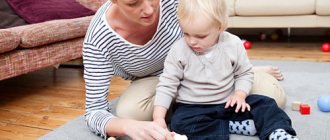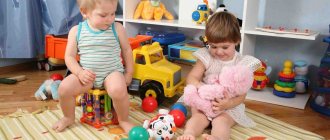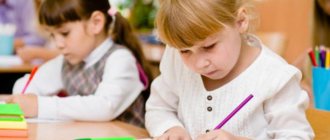Childhood is the most crucial period in the development of the personality of each of us. Of course, in the first months after birth, adults must provide the baby with proper care, provide adequate nutrition, give love, warmth and care, and stimulate development. But the real upbringing of a child begins after 1 year, when you can influence his behavior and instill the necessary principles and norms. It’s rare that any parent doesn’t wonder how to raise a one-year-old baby or an older child. It is especially difficult if this is the first-born. It is important for mom and dad to learn to maintain a balance between strictness and adherence to order, on the one hand, and loyalty, relying on the individual characteristics of their child, on the other. Here are the main aspects of how to raise a child from one to two years of age.
What should the education of a 1-2 year old child be aimed at?
- Building trust in the world and people around you.
- Development of mental processes (thinking, speech, memory, perception of colors, shapes, etc.)
- Attentive attitude to the health and nutrition of the baby.
- Development of independence and self-confidence.
- Self-care skills training.
- Formation of cognitive interest.
- Instilling the “first” rules and norms of behavior (what is “good” and what is “bad”).
- Unlocking the child's creative potential.
The Foundation for Successful Parenting
The point is that certain conditions (“if”) of interaction with a baby from birth to one year later influence his development, obedience and acquisition of new skills. So, raising a child from 1 year and older will be more favorable if, from the first days of his life:
- a healthy attachment has formed between you and the child;
- you treated the baby with love and tenderness, showed care;
- responded to his needs;
- they didn’t leave him to cry alone, but were there and tried to calm him down and help him;
- gave positive emotions, smiled at the child;
- constantly maintained physical contact (picked, hugged, kissed, massaged, etc.)
If the parents were sincerely able to display this behavior, then they were able to establish positive emotional contact and a trusting relationship with the child. This means that it will be easier to direct his behavior in the right direction in the future.
If something was missed, and “gaps” were revealed in interaction with the baby, then difficulties may arise in upbringing. And the sooner you notice them and want to correct them, the easier it will be to correct the situation.
Health of a one-year-old child
A visit to the pediatrician every year is considered a mandatory procedure. The doctor takes the necessary tests from the child and makes physiological measurements. The issue of child vaccination is also being addressed. It is also necessary to visit the following specialists: neurologist, surgeon, orthopedist. Additionally, it is advisable to consult an ophthalmologist and dentist.
An important component of a healthy lifestyle is maintaining the child’s personal hygiene. At one year of age, a baby can learn to wash his hands before eating and after a walk, as well as wash himself. If a child has grown at least 1 tooth, it is worth making friends with a toothbrush. And, of course, do not ignore evening bathing and rinsing in the shower.
Features of children 1-2 years old
- The child’s motor activity increases as he begins to walk independently, becomes more dexterous and able to control his body.
- The child gradually begins to master speech, his thinking develops, he better recognizes colors and shapes.
- He learns to manipulate objects. He grabs them and tries, following the adults, to use them for their intended purpose. At this age, play becomes an important way of understanding the world around us.
- There is a desire to eat independently, the baby learns to properly handle cutlery and drink from a mug.
- Most children at this age begin to use the potty.
- In the period from one to two years, the child is most often weaned from the breast, and a complete transition to “adult” food occurs.
- The child begins to understand your simple requests (“bring it”, “let’s put it away”, etc.), distinguishes between instructions “possible” and “not allowed”.
- A 1-2 year old child still has a strong dependence on his parents, so communication with them (and close relatives) is quite enough for him for now. At this age, he is usually not drawn to peers, because he perceives them not as other children, but as some moving objects that can be examined, touched, pushed. The kids don’t yet want to play and communicate with each other.
- The child is still very impulsive, needs a constant change of activity, and quickly gets tired of activities.
- His nascent desire for independence is often expressed in refusals: he says “no”, “I don’t want”, breaks away from his hands, runs away if adults ask him for something or order him to do something. In many children, such negativism begins to manifest itself at the age of 1.5 years. This resistance and the word “no” uttered by the child should be understood in most cases not as “bad character” and capriciousness, but as a desire to express one’s own opinion and demonstrate strong-willed qualities.
- Usually, after a year, the baby begins to show interest in certain creative activities: drawing, modeling from plasticine, putting together puzzles, mosaics, creating any structures, music, dancing, etc. It is important to observe your child in order to identify a tendency towards one or another activities.
Physical development of a one-year-old child
Statistics show that, on average, one-year-old children weigh 10-11 kg, and their height is approximately 72-77 cm. In this case, weight gain should be about 350 g per month, and height - 1.5 cm per month. After a year, the pace of the child’s physical development will gradually slow down.
Many mothers unwittingly compare their child's development with the development of other children, which causes many reasons for concern. “What if there’s something wrong with him?”, “I probably don’t do enough with the child,” and so on. It is worth noting that the pace of physical development up to one year is individual for each child. In this regard, only a really strong lag from the average statistical norm should be a reason for concern.
As a rule, by the age of 1 year, a child can sit, stand (with support), actively crawl and begin to take his first steps. One-year-old babies love to walk along the support and by the hand, and some even try to run. Also, with the help of an adult, the baby can slowly go up and down the stairs, climb on and off the sofa. Thanks to the ability to maintain an upright position, the baby's ability to explore the world expands. This is a very important step in the development of the baby. To help your child learn to walk confidently, do not force your help on him. Let the baby learn to walk short distances on his own, for example, to you or to a toy. Belay him at arm's length.
Since children of this age love to conquer all kinds of peaks, it is necessary to provide the child with proper safety. Do not leave your child unattended in a room with open windows, shelves that could be knocked over, electrical outlets, wires, or other dangerous objects.
Mistakes parents make when raising children after 1 year
It is important to remember how you cannot raise a child at 1-2 years old, and to exclude the following methods of interacting with him from your behavior as early as possible.
So, mistakes in parenting that interfere with the harmonious development of a child’s personality:
- Perceive your child as a smaller copy of an adult, get annoyed when he does not respond to your serious admonitions and arguments. A child at any age is a person, but with his own inner world and understanding of everything that surrounds him. To communicate with him, there must be a special “language”, which parents need to master, and not try to force the baby to understand dry “adult” thoughts and words.
- Not paying enough attention.
- Stop the child’s initiative and independence. It’s better to stop yourself once again when you want to tell him: “You don’t know how to do this. Let me do it better."
- Let the baby's development take its course. The more useful activities you do with him, the better for the educational process as a whole and the establishment of a strong emotional connection with the child.
Storm of emotions
Until one and a half to two years old, a child needs very few words to be understood. He babbles or points at the desired object. If his mother does not understand him or does not consider it possible to give him what he wants, he begins to cry, stomp his feet, and express aggression. Some children, having not achieved what they want, are able to quickly switch to something else. Others find themselves so caught up in their emotions that they can’t stop and calm down. This is a difficult test for parents who themselves find themselves in the grip of conflicting feelings. Anger at the raging child is mixed with pity for the little “sufferer.” And you are torn between the desire to give in to him and firmly stand your ground.
Raising a 1-2 year old child
And finally, about the positive. Below are recommendations on how to properly raise a child of 1-2 years old.
- Pay as much attention as possible. At this age, the baby definitely needs it. He wants to share his emotions with you, show you what he has learned, receive your approval, rejoice together, communicate a lot, play, etc. No gadgets, cartoons or super toys can replace you. The child needs your presence and attention. Give yourself to him, because this period is very valuable for both of you.
- Encourage your child to learn basic self-care skills: going to the potty, washing hands, eating and dressing independently. It is important that by the time he starts attending kindergarten, he knows how to do all this.
- Stimulate speech development. Conduct special classes, talk to your baby emotionally, use different intonations, clearly pronounce the words you teach him. Communicate more with your child, comment on everything around him: when you are walking, showing a book or magazine, watching a cartoon, or just playing.
- Help your baby learn to fall asleep on his own. Certain rituals contribute to this: singing a song, reading a fairy tale, telling a story, putting toys to bed, etc. It is important to ensure that the child falls asleep without your breast, without rocking and is in his own crib.
- Encourage the development of independence. The correct position of adults in this case is to observe, guide, help, support, and give confidence (if the child’s actions are not dangerous to his health and do not contradict his upbringing). But be sure to be close, your control is still necessary here.
- Give mini-tasks that are understandable for the baby: “Please bring…”, “Let’s collect toys”, “Put the pencils in a box”, “Put on...” At the same time, try to introduce him to order and neatness. Praise for well-completed tasks.
- Alternate quiet activities with active games. Switch your child’s attention from one activity to another more often. Don't forget about exercise and exercise. The baby needs to move a lot.
- Encourage the expression of feelings. This way you will help your child cope with surging emotions, teach him to better understand himself and other people. Describe his behavior in words, for example: “You are angry” or “You laugh so cheerfully!”
- Don't yell or use physical punishment. Be patient. It’s better to calmly explain 10 times that “this is not possible” than to shout once. Watch your words. The baby feels everything and is easily offended.
- Encourage your child to interact with other children. Observe how he behaves in the presence of his peers. Explain how to communicate with comrades, that you need to help and be friends. Give examples from books and cartoons.
- Spend more time in crowded places, as guests, and help your child get used to others and not be afraid of your relatives and friends. Gradually we need to prepare him to attend kindergarten.
- You and your behavior are an example for a child. Your actions must match your words. In this case, education will be clear and effective. The baby reads your emotions, gets infected by your mood and often copies your actions. Try not to be contradictory. Demonstrate optimism, confidence, kindness and empathy.
All in our hands. The more mature methods of education we choose, the more mature the child’s personality becomes.
First period
The first stage lasts from the moment the child is born until he is three months old. During this period, parents must form good habits in the baby and prevent the emergence of harmful ones, lay the foundations of communication, and develop sensory perception. Also, during this period, parents need to properly organize their diet; this is important for normal weight gain and the formation of a habit of a diet. In the first three months, the baby should develop the following habits:
- falling asleep outside without a pacifier;
- hold head;
- spend some time in bed, entertaining yourself;
- show signs of dissatisfaction when it is necessary to change a diaper;
- fall asleep without motion sickness;
- navigate in space, responding to sounds and light.
Particular attention must be paid to the baby’s hygiene. Every morning should begin with a mother’s friendly smile and hygiene procedures. They consist of washing the face and hands, changing the diaper and washing. Daily procedures will form a healthy habit of cleanliness in your baby. It is unacceptable for residual urine or feces to irritate the baby's skin, so diapers should be changed every three hours. Since children's skin is very delicate, its surface is treated with cream or powder.
To form the habit of holding the baby's head, it is necessary to lay it on his tummy, even if he expresses dissatisfaction. Gradually, this procedure will become a habit for him, the muscles of his neck and back will be trained. Every day he will spend more and more time on his stomach and contemplate the world around him from a different position.
How to develop the habit of talking? In order for a child to start cooing, you need to play with him. It’s good that when the baby hears songs and nursery rhymes. Each action that is directly related to the child should be commented on, telling how to put on pants, a blouse, and how to change a diaper. When talking with your child, you should smile, this way a culture of communication will be established.
Important article: hygiene of a newborn baby
SO, the main tips and recommendations that you need to follow:
- For the normal development of the child’s psyche, it is necessary to constantly talk with the baby, sing songs, tell nursery rhymes, and turn on music to listen to. For the first games with the baby, it is worth choosing toys that promote the development of sensory perception;
- When the baby reaches the age of one and a half months, to strengthen physical health, it is necessary to lay the baby on his stomach every day, do exercises and massage;
- An important educational point is the need to teach a child to sleep in his own crib and spend some time in it on his own. (See useful material on how to teach a child to sleep separately);
- To prevent your baby from developing a bad habit in the future, do not allow him to suck his fingers.
Toys and games from 0 to 3 months
For babies up to 3 months, educational psychologists recommend toys that develop sensory, hearing, vision and coordination of movements:
- Rattles, bells, bells, etc. To develop hearing, ring a rattle in one ear of the baby, then in the other. Soon the baby will begin to turn his head towards the sound source;
- Bright toys made of various materials that you can grab and stroke. First, they are shown to the baby, stroked over the baby’s body, and placed in the baby’s hand. Soon the baby himself will begin to grab them and confidently hold them;
- A variety of mobiles (carousels) that are attached above the baby’s crib. Toys are placed at a short distance from the baby’s eyes (about 15-20 cm). See the article about music mobiles for the crib;
- Bracelet with a bell , which can be worn alternately on different hands;
- A balloon that can be tied to your hand. Soon the baby will understand that the ball moves thanks to the movements of his hand;
- Schematic representation of a human face . Babies love to look at such images. If you place the picture at a short distance from the baby’s eyes (approximately 25-30 cm), he will be interested in studying it while his mother is not around.











